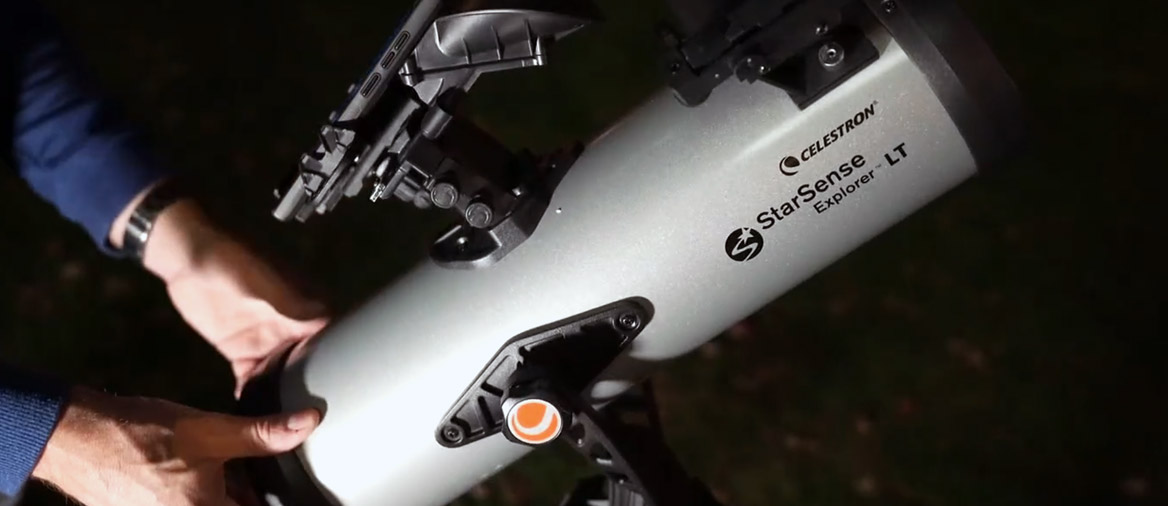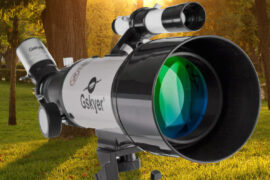Stargazing is an all-ages hobby. It is the kind of activity that you can do alone, or share with friends and family.
Starting out with astronomy and stargazing as an adult is nothing to be ashamed of. It might even have certain advantages over starting out as a kid because now you can drive yourself if you want to go to the field away from the city’s light pollution, and you might have a larger budget to work with.
But getting into this hobby as a beginner can seem intimidating. There are so many types of telescopes with different specifications that it can be hard to tell which ones offer good value and fit your needs.
This is why in this guide I’ll take a look at the best telescopes for adults. I have personally tested all of these myself. Thanks to this site, I’ve had the opportunity to test hundreds of models side to side, examine them thoroughly and ask real users about their experiences with them so I have a pretty good idea of which ones offer the best optics and value.
If you just want to skip to our best pick, here it is, but if you want to learn more about how to choose a good telescope and see other options, keep reading below.
Best pick – Celestron StarSense Explorer LT 114AZ
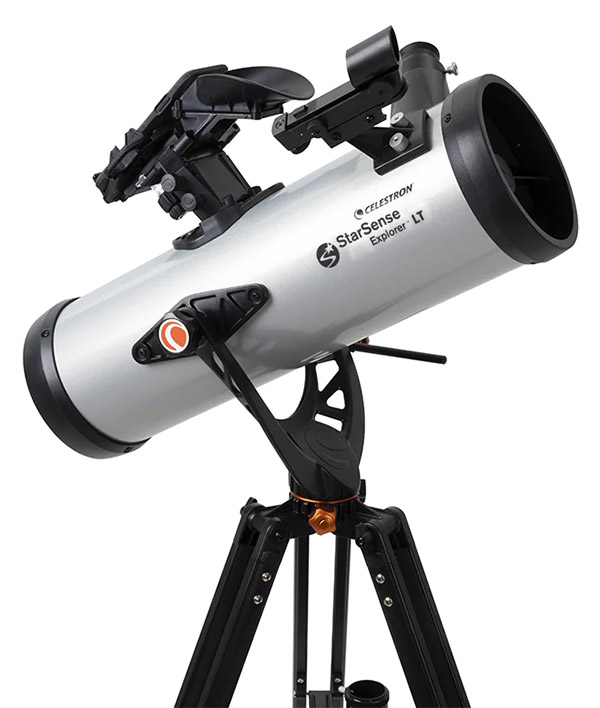
The star mapping technology of the StarSense telescopes is the best way to get started with stargazing.
If you have never used a telescope by yourself there’s one thing no one tells you about. It is not easy finding things in the sky without help.
In the past, hobbyist astronomers had to learn to star-hop or try to figure out a printed gigantic star map. Thankfully, things are now much easier with technologies like the StarSense app.
The StarSense telescopes by Celestron come with a smartphone dock. You attach your phone, fire up the app, and follow the instructions to align it. Then, the app will automatically map out the visible sky for your location and shows an overlay on your phone showing the names of the stars, planets, and constellations you are looking at.
If you want to find a specific object like a galaxy or a nebula, you can search for it in the database. The app then shows you on-screen directions to guide you to the object so you can center it. Once you have it, you can look at it through the eyepiece and get an excellent view of it.
I can’t tell you how much time the StarSense app can save. It allows you to focus on actually looking at the things in the sky instead of spending a good chunk of the night trying to find them.
As for the actual telescope, it is a reasonably powerful device. The StarSense Explorer LT 114 AZ is a Newtonian telescope. It can see objects with a magnitude up to 13.5, which means it is powerful enough to see all the planets in the Solar system as well as all the brighter galaxies like Andromeda, the Triangulum Galaxy, the Sombrero Galaxy, etc.
The quality of the mirrors is great as you would expect from Celestron. It resolves images with excellent contrast, sharpness, and color. It suffers a little bit when it comes to brightness but that’s true for most Newtonians and it is not a major issue.
My only gripe with this telescope is the included accessories. It only comes with two basic Kellner eyepieces (25mm and 10mm) and one 2x Barlow lens. These are fine and will serve you well for a while, but for the price, I’d wish to see them include Plossl eyepieces which are the next step up.
In conclusion, you can’t go wrong with any of the StarSense telescopes if you are a beginner. I’m recommending this because it has a good balance of power vs price, but if you are looking for something even more powerful, there’s a 130mm version that also adds a slightly better mount. I also wrote a more in-depth review of the 114AZ here if you want to check it out.
How to choose a telescope for adults
Here are the main factors to consider to pick a telescope that fits your needs.
Telescope type
Telescopes can be classified into two main groups. Reflecting and refracting. We have written extensively about the advantages and disadvantages of each as well as their subtypes but here’s a quick summary.
Refracting telescopes are easy to use and don’t require maintenance. They offer better brightness and contrast but tend to show color errors and blurry edges. They are expensive to make in large sizes.
Reflecting telescopes are cheaper to produce in large sizes so they generally offer more power for the same money. The downside is that they require maintenance and cleanup every once in a while. Reflectors fix the color issues but generally resolve dimmer images.
As you can see, there is no clear winner as they are both very balanced when it comes to pros and cons. For kids and teenagers, we generally recommend refracting telescopes because they don’t require maintenance, but for adults, there is no wrong choice and it comes down to whether you want more power or ease of use.
It is important to note that some specialized or hybrid telescopes fix some of the issues listed above. For example, astrophotography refractors use a design that solves the chromatic (color) issues.
Aperture
Aperture is the most important number for a telescope.
It refers to the diameter of the main mirror or lens of a telescope. As a result, it determines the maximum amount of light that the telescope can capture.
Having larger mirrors means that you can capture more light and therefore, more detail out of any image. While things like the quality of the mirrors and lenses in your telescope and accessories matter, the easiest way to get better images when stargazing is to get a model with the largest aperture possible.
The aperture is also going to determine the maximum magnification and magnitude that a telescope can reach.
Portability (size and weight)
How much portability matters is going to be a personal choice and is going to depend on how you plan to use your telescope.
If you are going to use it mostly in your backyard and you have enough storage room (see our telescope storage guide) then you can think about maximizing power and getting the biggest, bulkiest telescope within your budget.
On the other hand, if you plan to take it out on the field you will need a compact and light telescope.
I have tried to offer options for both extremes and middle points in the recommendations below.
What other specs mean:
Focal length: It is the total distance the light travels between the main mirror and the exit pupil. It affects the field of view (the area of the sky you can see), but it can be “modified” with accessories. For astrophotography, a short focal length is important.
Focal ratio: It is the result of dividing the focal length by the aperture. It is expressed like f/7, f/6.25, f/4, etc. A low focal ratio is important for astrophotography, but for every other use case, it is not very relevant.
Highest magnification or highest useful magnification: The maximum magnification (power) that a telescope can reach. It is determined by the aperture, check our magnification calculators to get it. It is also going to determine the highest-powered eyepiece that the telescope can use. Going beyond that is going to result in blurriness or just wasted money as you won’t get any more detail.
Best telescopes for adults
Best value – Celestron AstroMaster 130EQ
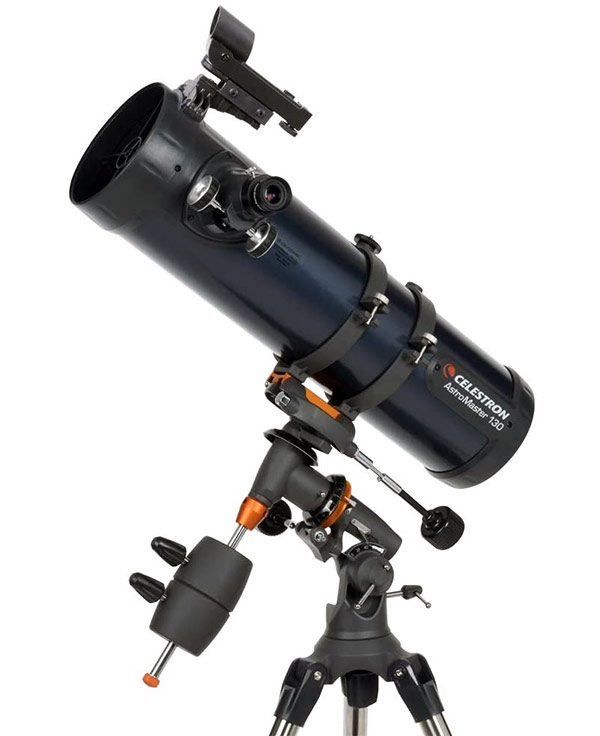
Powerful Newtonian telescope that offers a great balance of quality and cost.
When it comes to price-to-value ratio it is hard to beat Newtonian telescopes. They can give you a lot of bang for your buck.
The Celestron 130 EQ has an aperture of 130mm (5.1 inches) which results in a maximum magnification of 269x. Compare that to the 165x that a standard 70mm telescope will give you and the difference in detail and power is quite significant. We have sample photos taken with this exact model in our article about what to expect out of a 130mm telescope. You can compare them to the photos taken on a 70mm and you’ll see the difference.
The Celestron 130EQ has been one of the most popular models in the market for years and with good reason. Celestron is well-known for the solid optics and build quality of their products. While they are not on the same level as more specialized brands like SkyWatcher or Meade, they make great consumer products that are even used in the astrophysics departments of some universities.
Newtonian telescopes have a steeper learning curve than more basic designs, especially if they come paired with equatorial mounts like this one. However, this also means that they will grow with you and once you learn to get the most out of them, they’ll allow you more freedom and options. You won’t feel like they are limiting you or that you need to upgrade. You can expect it to last for a very long time.
In conclusion, the Celestron AstroMaster 130EQ is a great value purchase, especially for adults that are looking to get a first telescope that has a good balance of power against cost.
Most powerful – Orion Skyquest XT8
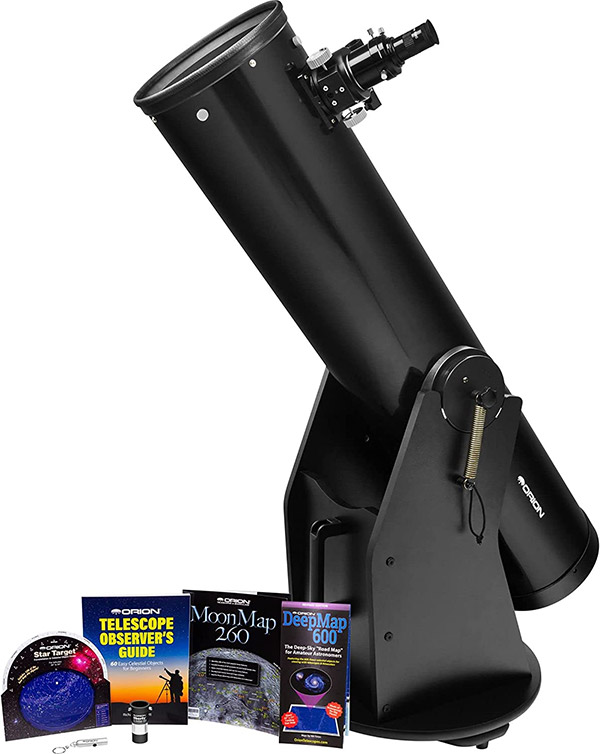
A very large telescope for those looking for the maximum magnification available. Solid build quality, extremely durable.
Dobsonian telescopes are the easiest telescopes to manufacture in large apertures. There is even a large DIY community of people that build their own because of their relatively low cost for the power they pack.
Their design allows the to capture lots of light, resulting in highly detailed images. This is why they are often nicknamed “light buckets”.
The downside, as you can deduce from their appearance is that they are not exactly mobile and they require constant cleanup because of the open design on the front.
But if you are looking to maximize the power and detail of the images, then a Dobsonian might be the right fit for you.
The Orion Skyquest is the most well-known line of Dobsonians on the market. Orion makes high-quality mirrors and solid devices.
The XT8 is the middle child of the lineup but offers in my opinion, the best value. It has an aperture of 203mm (8 inches) and a generous focal length of 1,200 mm.
Unlike most of the other models in this list, it supports 2″ eyepieces. This size is usually reserved for high-magnification eyepieces or wide-angle models and the Skyquest XT8 can make good use of both. It also comes with a 1.25″ adapter to fit standard eyepieces.
There are 6″ (150mm) and 10″ (254mm) models of it, the XT6 and XT10, but I think this one offers a good middle point. If you are looking for power, check this one out.
Budget option – SOLOMARK 70mm EQ
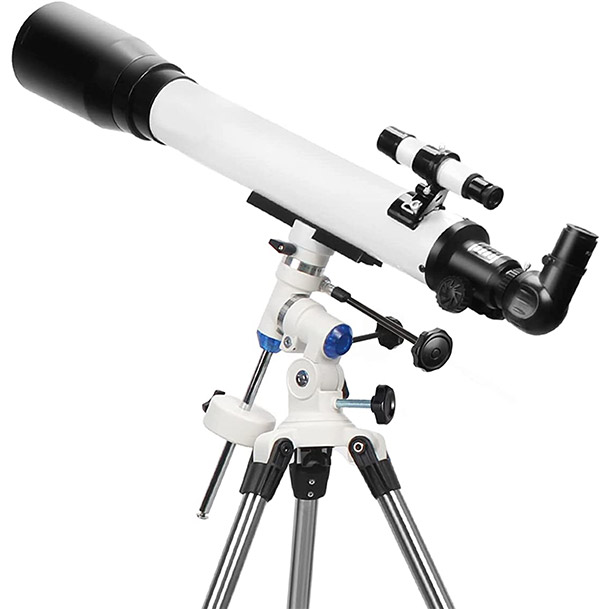
A solid entry-level refractor with good optics and accessories that are usually only foun on higher-end models.
If you are still not sure that you want to invest a considerable amount of money into the hobby and you are just looking for an entry-level device that still allows you to see some cool stuff in the sky, there are also many options in that range.
When it comes to budget telescopes, small refractors are usually a better option because they are more versatile and can be used as both portable and home telescopes.
I have an in-depth review of this SOLOMARK 70mm EQ model if you want to check it out so I’m just going to summarize what I already wrote there.
There are dozens of 70mm refracting telescopes on the market. It is the most popular size for entry-level devices. Excluding the cheap knock-off brands, it is hard to differentiate the rest as the aperture is not large enough for the eye to be able to differentiate much detail between each of them. So why did I specifically pick this one?
Well, 70mm telescopes are designed so that anyone can use them, including kids. As a result, they sacrifice a lot of features for the sake of being “point and shoot”. The problem is, these telescopes can be outgrown quickly and you will soon find yourself with the need to upgrade.
As an adult, you probably have a bit more patience to learn so a telescope that grows with you is a better fit.
That’s why I chose the SOLOMARK 70mm EQ. Because it comes with a really good equatorial mount that is usually only found on larger telescopes, and it also comes with Plossl eyepieces which are considerably better than the basic Kellners that are usually included. This means that you won’t need to upgrade them anytime soon.
When you factor that in and realize that the price of this model is still competitive with the competition, you realize that it is a great deal, and one of the best budget options out there.
(If you are still not sold on the SOLOMARK, check out more options in this article about the best budget telescopes.)
Best portable/travel telescope for adults – Celestron TravelScope 80mm
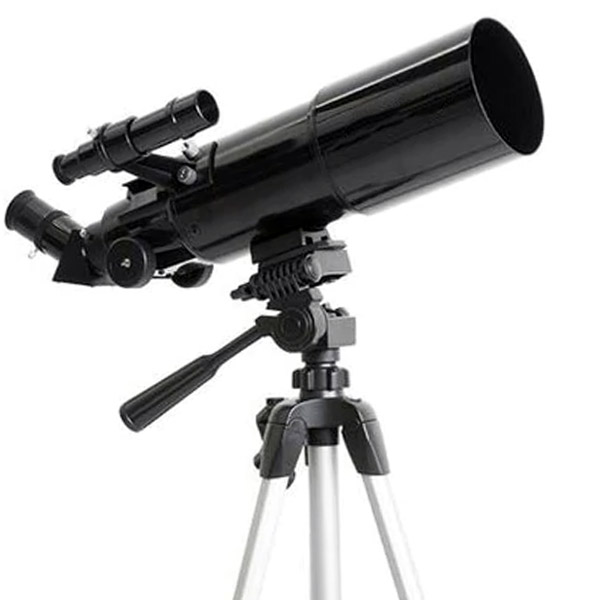
A solid entry-level refractor with good optics and accessories that are usually only foun on higher-end models.
Travel telescopes are an interesting category because it is the one use case where you have to value portability over the aperture. Balancing both can be tricky because you don’t want to end up with a lightweight, but underpowered device.
For portable telescopes, I generally recommend 70mm-102mm refractors. Any lower than that is just not good enough to have an enjoyable viewing experience and won’t even allow you to see the outer planets of the Solar system.
One of the main ways manufacturers reduce the size of ravel telescopes is by minimizing the focal length. While this makes them suffer a bit when it comes to observing deep space objects due to the reduced field of view, it is actually preferable for planetary viewing.
I chose the Celestron TravelScope because it offers high-quality optics which is absolutely necessary for this category and because it comes bundled with a backpack and a smartphone adapter to take photos.
There is a 70mm version that is slightly more affordable, but in this case, I think the extra aperture in the 80mm model is worth the small price jump.
Best for astrophotography – SVBONY SV503
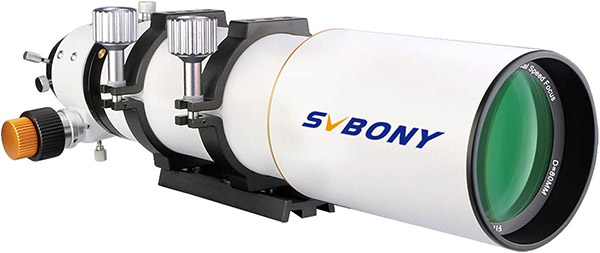
Excellent entry-level tube for astrophotography. It offers gorgeous views and high-end features at a reasonable price (for astrophotography gear).
Astrophotography is a whole different hobby than simple stargazing. Not only do you need to learn to use a telescope, but you have to mix that with photography which is a very large field. This is a hobby for the faint of heart, but the results can be so satisfying when you finally start getting good photos of galaxies and star clusters, making all the effort (and the gear cost) worth it.
There are very few entry-level astrophotography telescopes. Manufacturers focus more on the high-end market because it is the kind of activity that does require a considerable investment. However, out of the few that are available, the SVBONY SV503 stands out.
This telescope is a 70mm refractor OTA (which means it is just the tube with no tripod/mount) with a focal length of just 560mm. With those specs, you might be wondering why does it cost many times more than other 70mm telescopes?
Well, astrophotography telescopes are a special case because they use different internal designs and special lenses to get sharper, brighter images, as well as eliminate any chromatic (color) errors. But that also means the price is going to be very different from a standard device. They are high-end, premium models.
The SV503 uses a doublet design, which means it refracts the light using two lenses instead of one. The lenses are also ED – for Extra-low Dispersion – which means they absorb less light and transmit more to the exit, resulting in brighter images and a lor more detail than the average lens.
The images this little device can capture are truly impressive. SVBONY is a brand that usually focuses on the lower-end market, but here they have made a telescope that feels and performs like a premium model.
For the mount, I recommend going with a SVBONY SA402 simply because it has been tested with it but any M42 or M48 e-mount will work. I recommend checking this blog post on SVBONY’s site to get a better idea of all the accessories that go well with it.

